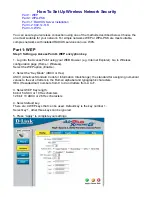
Wireless Music Router
www.cctairmobi.com
55
Appendix C: Glossary
802.11b:
The 802.11b standard specifies a wireless networking at 11 Mbps using direct-sequence
spread-spectrum (DSSS) technology and operating in the unlicensed radio spectrum at 2.4GHz,
and WEP encryption for security. 802.11b networks are also referred to as Wi-Fi networks.
802.11g:
Specification for wireless networking at 54 Mbps using direct-sequence spread-spectrum
(DSSS) technology, using OFDM modulation and operating in the unlicensed radio spectrum at
2.4GHz, and backward compatibility with IEEE 802.11b devices, and WEP encryption for security.
802.11n:
802.11n builds upon previous 802.11 standards by adding MIMO (multiple-input
multiple-output). MIMO uses multiple transmitter and receiver antennas to allow for increased
data throughput via spatial multiplexing and increased range by exploiting the spatial diversity,
perhaps through coding schemes like Altamonte coding. The Enhanced Wireless Consortium (EWC)
was formed to help accelerate the IEEE 802.11n development process and promote a technology
specification for interoperability of next-generation wireless local area networking (WLAN)
products.
DHCP (Dynamic Host Configuration Protocol):
A protocol that automatically configure the TCP/IP
parameters for the all the PC(s) that are connected to a DHCP server.
DMZ (Demilitarized Zone):
A Demilitarized Zone allows one local host to be exposed to the
Internet for a special-purpose service such as Internet gaming or videoconferencing.
DNS (Domain Name System):
An Internet Service that translates the names of websites into IP
addresses.
Domain Name:
A descriptive name for an address or group of addresses on the Internet.
DSL (Digital Subscriber Line):
A technology allowing data to be sent or received over existing
traditional phone lines.
ISP (Internet Service Provider):
A company that can provide access to the Internet.
MTU
(
Maximum Transmission Unit
): The size in bytes of the largest packet that can be
transmitted.
NAT (Network Address Translation):
NAT technology translates IP addresses of a local area
network to a different IP address for the Internet.
PPPoE (Point to Point Protocol over Ethernet):
PPPoE is a protocol for connecting remote hosts to
the Internet over an always-on connection by simulating a dial-up connection.
SSID (Service Set Identification):
It is a thirty-two character (maximum) alphanumeric key



































